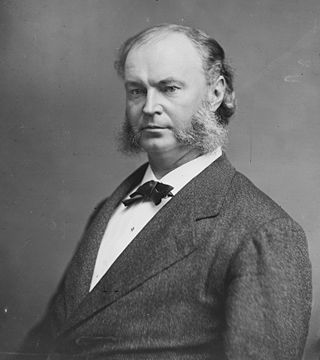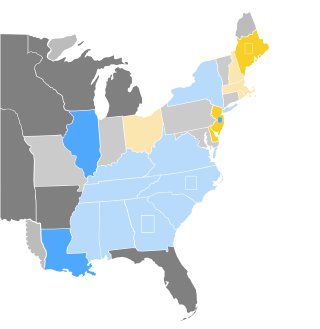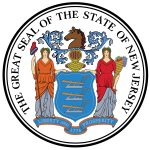
The 1828 United States presidential election was the 11th quadrennial presidential election. It was held from Friday, October 31 to Tuesday, December 2, 1828. It featured a repetition of the 1824 election, as President John Quincy Adams of the National Republican Party faced Andrew Jackson of the Democratic Party. Both parties were new organizations, and this was the first presidential election their nominees contested. This election saw the second rematch in presidential history, something that would not occur again until 1840.

Jonathan Worth was the 39th governor of the U.S. state of North Carolina from 1865 to 1868, during the early years of Reconstruction.
Willis Alston Jr. was a politician and planter from North Carolina. A member of the Democratic-Republican Party and later a Jacksonian, he served as a U.S. Representative in the 6th to the 13th Congresses (1799–1815) and the 19th to the 21st Congresses (1825–1831). He was the nephew of Nathaniel Macon.

The 1828–29 United States House of Representatives elections were held on various dates in various states between July 9, 1828, and October 5, 1829. Each state set its own date for its elections to the House of Representatives before the first session of the 21st United States Congress convened on December 7, 1829. Elections were held for all 213 seats, representing 24 states.
Ohio's 11th congressional district encompasses portions of Cuyahoga County in the Northeast part of the state—including all of Cleveland. It has been represented by Shontel Brown since 2021.

Theodore Fitz Randolph was an American attorney, businessman, and politician who served as the 22nd governor of New Jersey from 1869 to 1872 and represented the state in the United States Senate from 1875 to 1881. He was the son of U.S. Representative James F. Randolph.

The 1830–31 United States Senate elections were held on various dates in various states. As these U.S. Senate elections were prior to the ratification of the Seventeenth Amendment in 1913, senators were chosen by state legislatures. Senators were elected over a wide range of time throughout 1830 and 1831, and a seat may have been filled months late or remained vacant due to legislative deadlock. In these elections, terms were up for the senators in Class 3.

the 1828–29 United States Senate elections were held on various dates in various states. As these United States Senate elections were prior to the ratification of the 17th Amendment to the United States Constitution in 1913, senators were chosen by State legislature United States. Senators were elected over a wide range of time throughout 1828 and 1829, and a seat may have been filled months late or remained vacant due to legislative deadlock. In these elections, terms were up for the senators in Class 2.

The 1821 United States House of Representatives elections in New York were held from April 24 to 26, 1821, to elect 27 U.S. Representatives to represent the State of New York in the United States House of Representatives of the 17th United States Congress.

The 1826 United States House of Representatives elections in New York were held from November 6 to 8, 1826, to elect 34 U.S. Representatives to represent the State of New York in the United States House of Representatives of the 20th United States Congress.
Elections to the United States House of Representatives were held in Pennsylvania on October 14, 1828, for the 21st Congress. Members of three different parties were elected to the 21st Congress, the first time in US history that a third party won seats. The new Anti-Masonic Party won a total of 5 seats, 1 of which was in Pennsylvania.

A special election was held in Pennsylvania's 8th congressional district on October 13, 1829 to fill two vacancies in Pennsylvania's congressional delegation before the first session of the 21st Congress.

On December 15, 1829, a special election was held in Pennsylvania's 16th congressional district to fill a vacancy caused by the resignation of Representative-elect William Wilkins (AM) on November 9, 1829, prior to the start of the 21st Congress.

A special election was held in New York's 21st congressional district April 30-May 2, 1816 to fill a vacancy left by the resignation of Peter B. Porter (DR) on January 23, 1816 after being appointed a Commissioner under the Treaty of Ghent. The special election was held at the same time as the general elections to the 15th Congress in New York.

A special election was held in Virginia's 5th congressional district on January 21, 1826 to fill a vacancy caused by the resignation of John Randolph (J) on December 26, 1825, after being elected to the Senate.

A special election was held in Kentucky's 2nd congressional district on August 4, 1828 to fill a vacancy in Kentucky's representation.

Two special elections were held in Kentucky's 11th congressional district in 1827 to fill a single vacancy.

A special election was held in Mississippi's at-large congressional district on October 20, 1828 to fill a vacancy left by the resignation of William Haile (J) on September 12, 1828

The 1828 United States elections elected the members of the 21st United States Congress. It marked the beginning of the Second Party System, and the definitive split of the Democratic-Republican Party into the Democratic Party and the National Republican Party. While the Democrats cultivated strong local organizations, the National Republicans relied on a clear national platform of high tariffs and internal improvements. Political scientists such as V.O. Key Jr. consider this election to be a realigning election, while political scientists such as James Reichley instead see the election as a continuation of the Democratic-Republican tradition. Additionally, this election saw the Anti-Masonic Party win a small number of seats in the House, becoming the first third party to gain representation in Congress.

John Giles was elected August 13, 1829 to the term beginning March 4, 1829, but resigned from the seat without having served.













